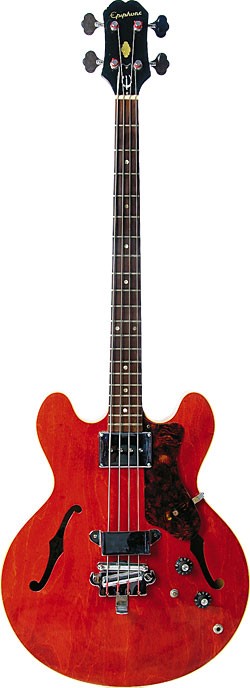
1967 Epiphone EB232C Rivoli, serial number 100530. Photo: Bill Ingalls Photography. Instrument courtesy of Bill Flippo.
Former Gibson president Ted McCarty (1909-2001) is credited for his leadership of the company when it peaked in terms of innovation, design, and execution. Under his guidance from 1948 until 1965, Gibson developed a reputation as the premier builder of solidbody guitars, separated from the Fender company’s utilitarian instruments by their fancy carved tops and set necks.
In 1999, McCarty told Vintage Guitar that the instrument he most admired from his tenure was the semi-hollow ES-335; he is credited for devising Gibson’s famed “thinline” configuration, which used a wooden center block under the guitar’s bridge, pickups, and tailpiece to increase sustain and structural strength. It also made the guitar virtually immune to feedback. But another significant accomplishment was more about McCarty’s role in marketing…
In 1957, Gibson’s parent company, Chicago Musical Instrument (CMI) bought floundering New York-based instrument builder Epiphone primarily because it produced a respected line of upright “doghouse” basses. And although Gibson ultimately opted to discontinue the upright bass, McCarty recognized that owning the Epiphone brand meant Gibson could sell instruments and amplifiers to stores that handled CMI lines but were not Gibson franchises; after the acquisition, Epiphones were made to the same standards, in the Gibson factory, and often had only minor cosmetic differences from certain Gibson counterparts.
The electric bass was another innovation that came into its own in the ’50s. Fender was first to successfully market one, but Gibson introduced its violin-shaped solidbody Electric Bass (VG, February ’06) in 1953, followed by the semi-hollow 335-style EB-2 in ’58, and the solidbody EB-0 in ’59 (replacing the original-design Electric Bass).
When it was introduced in ’59, Epiphone’s electric bass, the Rivoli, was a fraternal twin of Gibson’s EB-2; each had a thinline maple body that measured 16″ wide, 19″ long, and 13/4″ deep. Both had double rounded cutaways, unbound f-holes, and of course, the center block. Its neck was mahogany and its rosewood fretboard had 20 frets with dot markers on a 301/2″ scale. Like its Gibson counterpart, the headstock had rear-projecting, banjo-style tuners, as well as a plain one-piece bridge/tailpiece that was not intonatable but had an angled portion for better tuning stability. The first-version Rivoli also had a massive single-coil pickup mounted near the neck, and simple Volume and Tone controls. It, too, began its existence in natural and sunburst finishes.
As the EB-2 evolved in ’59 and ’60, so did the Rivoli, each acquiring standard right-angle tuners, a humbucking pickup, a pushbutton baritone switch, and a flip-up string mute. The differences between the two were primarily cosmetic – different headstock silhouettes with different pearloid inlays. The pickguards also had different configurations, and the Epiphone had the trademark circular E on its scratchplate. The ’67 Epiphone Rivoli shown here sports the Cherry Red finish that became an option the year before. It also sports the later hardware, plus a handrest seen on some examples. The E logo has worn off its tortoiseshell pickguard.
Curiously, despite their evolution, both were discontinued in the early ’60s, only to be reinstated in ’64, when semi-hollow basses became favored by “British Invasion” bands; the Rivoli actually became the higher-profile instrument as English players gravitated to its sound, light weight, and playability. Sunburst-finished Rivolis were utilized by the Animals (Chas Chandler), the Yardbirds (Paul Samwell-Smith), Gerry & the Pacemakers (Les Chadwick), the Small Faces (Ronnie Lane), and many others. Chandler reportedly used his Rivoli to record the intros to “We’ve Gotta Get Out Of This Place” and “It’s My Life.” And from 1964 to ’66, John Entwistle used a sunburst Rivoli as well as a natural-finish EB-2 as part of his arsenal in the High Numbers, which became The Who when the band changed its name in ’64.
Jimmy Page played a sunburst Rivoli during his tenure with the Yardbirds, perhaps the same one played by Samwell-Smith before he left the band – and Yardbirds rhythm guitarist Chris Dreja may have played it when he switched to bass after Page became the band’s sole guitarist during its final incarnation. Later in the decade, Free’s Andy Fraser utilized a natural-finish Rivoli.
The Rivoli was discontinued in ’69, but made a brief reappearance with two pickups in 1970 – the same year Gibson moved manufacture of Epiphones from Kalamazoo to Asia, where it remains today.
This article originally appeared in VG‘s March 2009 issue. All copyrights are by the author and Vintage Guitar magazine. Unauthorized replication or use is strictly prohibited.
1966 Epiphone Rivoli, It’s my life by the Animals



